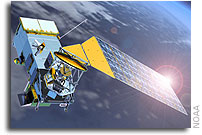Prepared Testimony for Under Secretary of the Air Force Ronald M. Sega – House Science Committee Hearing on NPOESS

INTRODUCTION
Mr. Chairman and members of the Committee, I am honored to appear before you today to address the state of the National Polar-Orbiting Operational Environmental Satellite System (NPOESS). In my role of overseeing Department of Defense (DoD) space activities as Under Secretary of the Air Force and the Department of Defense (DoD) Executive Agent for Space, I am committed to preserving the space capabilities that our commanders and forces depend on to conduct their missions.
NPOESS STATUS
The NPOESS Integrated Program Office (IPO), made up of DoD, Department of Commerce (DoC), and National Aeronautics and Space Administration (NASA) personnel, was formed in December 1994, in response to the President’s direction to converge the DoD and DoC polar weather satellite systems: the Defense Meteorological Satellite Program (DMSP) and the Polar Orbiting Environmental Satellite (POES), respectively.
Since that time, the program has experienced several development challenges, culminating in the Nunn-McCurdy notification to Congress on September 28, 2005. We notified Congress that the NPOESS cost has grown at least 15%. Currently, the OSD Program Assessment & Evaluation Cost Analysis Improvement Group is independently assessing the NPOESS program cost and expects to complete their work in December 2005. We will provide the results of their effort to this Committee when it becomes available. As we address the issues
with the program and the risks of completing the acquisition, we acknowledge the possibility that the cost estimates may grow even higher. Hand-in-hand with the cost growth, the launch date has slipped; we anticipate the first NPOESS launch no earlier than fiscal year 2012.
The NPOESS Executive Committee (EXCOM) chartered an Independent Program Assessment (IPA) team to support the establishment of a clear and unambiguous program baseline and cost estimate. In addition to an in-depth analysis of the current program, the IPA is currently exploring several options for a re-structured NPOESS program; however, these are preliminary and further evaluation is needed.
We expect the EXCOM to direct a program re-plan based on the IPA recommendations while taking user requirements into consideration through the Senior Users Advisory Group (SUAG), a Flag Officer/SES-level group from nine organizations within NOAA, the Air Force, NASA, the Joint Staff, the Navy, and the National Weather Service. For the re-plan, the IPO will build a detailed cost and schedule estimate in early calendar year 2006, prepare a new Acquisition Program Baseline, and update the Selected Acquisition Report. Once the new estimates are complete, the DoC and DoD will implement the new program baseline through each Agency’s funding processes.
One of the IPA’s preliminary findings is that too much work has been deferred to maintain the current program schedule. Even if additional FY06/07 funding were provided, the program could not maintain the current schedule because development of various sensors requires more time for integration and testing in order to reduce overall mission risk.
AVOIDING COVERAGE GAPS
Building and launching NPOESS is critical for our nation’s weather forecasting capabilities. Currently, polar orbiting platforms provide over 90% of the data used in DoC and DoD prediction models. A gap in polar coverage will impact commanders’ situational awareness and operational mission planning. These satellites also provide low earth orbit space environment monitoring which is needed for effective precision navigation, communications and missile defense operations, and the operation of all orbiting spacecraft.
Polar-orbiting meteorological spacecraft also help with protecting both military and civilian property. For example, if polar-orbiting microwave imagers or infrared sounders are not available, hurricane forecasts will be degraded.
If we encounter or anticipate a significant gap in polar satellite coverage, we would potentially employ several overhead platforms — spaceborne and airborne — to provide weather data. For instance, we may partner with NASA to use data from their research satellites in Air Force weather models. In addition, the Air Force is currently evaluating the usefulness of the high altitude flight regime using long-duration missions in the upper atmosphere for persistent coverage of mission areas not visible to geostationary satellites. Finally, one way we may minimize a gap in coverage is through a DMSP Service Life Extension Program aimed at increasing the lifespan of critical components.
CONCLUSION
NPOESS is important to the future of DoD weather forecasting. The Air Force is responsible for weather forecasting for global military operations to include in areas where data is unavailable or denied. Presently, DMSP is a key assured source of data to accomplish that mission. Geostationary satellite data is of lower spatial resolution and cannot cover latitudes higher than 67 degrees — yet high latitude conditions are major drivers of worldwide weather. Polar-orbiting satellites such as NPOESS, as the eventual replacement for DMSP, are necessary to support national security objectives.
I appreciate the continued support of the Congress and this Committee to deliver vital capabilities to our warfighters and ensure we have the forecasting and remote sensing capabilities we need.








